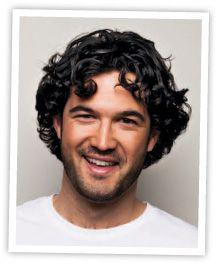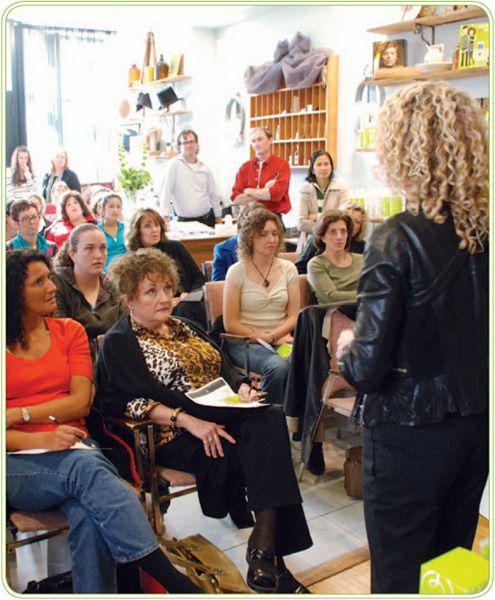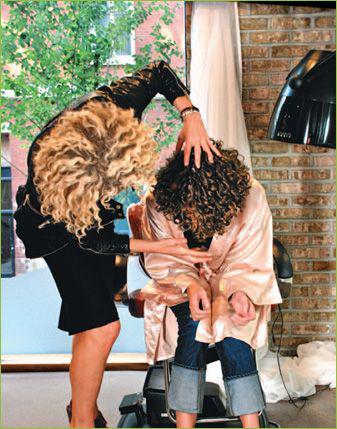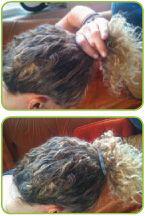B003YL4KS0 EBOK (33 page)
Authors: Lorraine Massey,Michele Bender

Allesandro grew out his hair from a short crop to the longer locks, right.

By being patient, Allesandro now has the long curly locks he wanted.
CURL CONFESSIONAllen Salkin
investigative reporterI had gotten accustomed to being butchered. Envision it: I entered a salon, a barber shop, some place I thought my hair might have a chance of being safe. I did not want to be there, but my hair was unwieldy, demanding a trim. I pretended to be friendly to the person who greeted me, pasting a smile on my face, and then asking some inane question of the haircutter, like, “How long have you worked in this neighborhood?” I was like a prisoner trying to charm the person who is about to torture him, hoping that perhaps a bit of fake friendliness will entice the torturer to not break the prisoner’s knuckles quite so unevenly this time. It was stupid, because I knew that it was extremely likely this person would do to me what all the other scissor wielders had done: cut and cut and reshape, and try to balance things out.
The haircutter would mutter: “Oh, I need to just clean that up.” For them “clean that up” meant diving into my curls like a gardener with shears attacking an overgrown rhododendron. Snip snip. Hack, hack, hack. And there I’d be, feeling like 10 pounds had been cut off my head, a sort of pleasant feeling at first, an airy lightness, until I’d look in the mirror and see that this haircutter’s version of cleaning things up was the same as all the others: hacking most of the curl out of my hair and getting down near scalp level.
It is hard to describe to someone who doesn’t have curly hair what it is like to walk out of a salon and feel like all your power is gone, like someone has reached into your secret pouch of magic dust, pricked a hole in the bottom, and let the contents fall uselessly onto a dusty floor, where some minion will sweep it up like a bunch of poodle crap and throw it away with dirty cotton balls and half-eaten bananas. Poooof.
Listen, life isn’t perfect. My stomach isn’t the flattest. The stories I write sometimes get edited in ways that make me cringe. My neighbors sometimes cook things that smell awful. I’m not special in a lot of ways. But my hair is special. Somehow it expresses who I feel myself to truly be. It curls in strange double-helix coils like DNA, proud of its essence. It speaks. It lives. Sometimes when I’m down, the curls lie limply. Happy, and they bounce. And on those days when the wind dries my hair out and it flies in a jillion directions like straw ready to catch fire in a field, I will stop and realize something isn’t right with my thinking about life. What do I need to change? Get it right, and the curls seem to regain their spring.

Accepting my curls is Zen: Every day is a new day.

Q
Why doesn’t the front of my hair grow as long as the back?
CAUSE AND EFFECT
A
The hair around your face, like the windshield of a car, is constantly exposed to wind, rain, heat, and other environmental factors, and therefore has a shorter life span than the rest of your hair. But you can mend and protect these tendrils by nurturing them with extra doses of conditioner and handling them gently. Pay attention to the damage you may be unwittingly inflicting on your hair by pulling it, playing with your bangs, or running your fingers through your locks.
Q
How come my hair doesn’t grow past a certain point?
LONGING TO GROW
A
Lots of curly girls complain about this. When you’re using sulfate-filled shampoos, the ends of the hair get eroded and fray, stunting your hair’s growth. Once you have weaned your strands off these damaging substances and your hair is hydrated again, it can and will start to grow.
Q
How can I exercise and keep my curls looking great?
WORK IT OUT
A
If you know you’re going to cleanse your hair after a workout, simply tie it back at the nape of the neck or up at the crown with a fabric-covered ponytail holder, ribbon, or scarf. If you don’t plan to shower after your workout and your bangs are short, either use a thin headband right at the front of your hairline to move the shorter pieces off your face (after the workout, this can give you a nice root lift, too) or twist the curls that frame your face back to the crown and anchor them with bobby pins. The twists will stop frizz and regenerate your hair’s shape while harnessing it in place. Then gather the rest of your curls in a low or high ponytail, depending on your preference.
You can also try the Unicorn ponytail or the Samurai Bun (see
pages 145
–146).
Q
How can I protect my curls while wearing a hat, bike helmet, or wig?
PROTECT + REVIVE
A
Curls have a cushioning nature and revive forgivingly with the right touch, especially those that are healthy and hydrated. So it’s easy for your hair to recover from being compacted under a hat, hood, helmet, scarf, cap (like those worn by doctors and nurses), or a pair of earmuffs. In general, these things don’t cause frizz, just flatness. And if the hair is positioned correctly beforehand, covering it can help set the hair and reduce frizz. Here’s how:

1
Before putting on a hat or other head covering, apply gel directly to a clip or bobby pin, then place the clip or pin at the roots of the hair perpendicular to the scalp. A clip will keep the roots elevated while the weight of your head covering is pressing down on them.
2
If your hair is past shoulder length, gently gather it at the nape of the neck with a fabric-covered ponytail holder. Twist the curly tail upward and anchor it to the back of your head with bobby pins. If you have short curls around the front, take sections of these hairs and twist them backward toward the crown. This quick positioning of your curls will keep them in their natural formation, and they will regenerate when you set them free again.
3
When uncovering your hair, resist the urge to fluff it up. Instead, spritz it with lavender spray or wet your hands slightly under a running tap and place damp fingers at the roots. Tilt your head over and gently shuffle your fingertips to open the hair. Lift your hands off the scalp without running your fingers through your hair. Then scrunch the hair upward in the same manner that you scrunch gel when styling.
4
To give the top layer of hair more lift, lightly spritz a few of the flattened curls with lavender spray or water. Twist each section around your index finger, then slide the curl off and either pin or hold it in place with your fingers for a couple of minutes. (If water isn’t available, just lick your finger to create the proverbial spit curl.)
Q
How can I protect my curls while I sleep?
SLEEP-IN BEAUTY
A
Tossing and turning in bed at night causes a lot of friction. I suggest that you get a pillowcase made of silk, cotton sateen, or very high thread-count cotton to reduce friction and minimize split ends. The softer and more luxurious the cotton, the less damage it will do to your hair. You can also do one of the following:
•
Sleep Like a Geisha:
Lie on your back and spread your hair over your pillow like you would spread out a veil. Just make sure to put a pillow right under your knees so you’re in an ergonomic position with your nape and knees elevated. Sleeping on your back also prevents the hair on the side you sleep on from becoming weaker than the hair on the other side.
•
The Unicorn:
Bend forward at the waist and tilt your head forward. Gather your hair gently at the center of the forehead with a fabric-covered ponytail holder, ribbon, or scarf. If
your hair is really curly, pull it through so it’s free flowing. The Unicorn prevents the ends of your hair and the curls at the nape of the neck from getting knotted, and also prevents frizz if it rains during the night. The next morning, remove the ponytail holder. Spritz the hair with lavender spray or wet your hands slightly, place your fingertips gently on your scalp, and lightly shuffle hair at the roots. Then let your hair settle. This process will loosen the curls at the nape without disfiguring them, and they will appear longer the next day.


